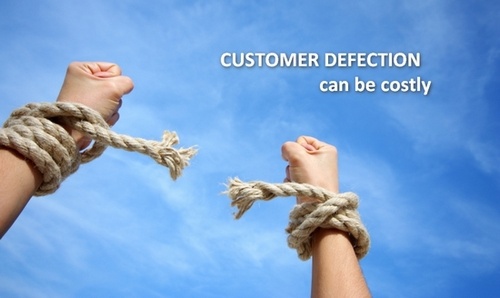
How to reduce customer defection and bring down defection rate?
Home » Marketing » How to reduce customer defection and bring down defection rate?
How to reduce customer defection and bring down defection rate?
February 3, 2020 By Hitesh Bhasin Tagged With: Marketing
It is a known fact that one of the variables which hit’s the bottom line of all established companies hard is the customer defection rate. The customer defection rate is the rate at which existing customers leave the brand and switch over to a competitor. It is possible that the customer has stopped using this type of product altogether. Or the more likely scenario is that the customer has switched over to a competitor.
In fact, the defection rate is higher now, and more than ever in the current market environment. It is very common nowadays to acquire customers by giving schemes and discounts. However, research has found that customers who have been acquired because of discounts, have half the customer life time value as compared to customers who have been acquired without any additional monetary benefits.
The second type of customers, customers acquired solely through the company and product value, are more likely to stay with the brand longer. This is the crux of solving the problem of customer defection.
If you want to reduce customer defection, you need to find out why the customer is defecting from your brand. There can be many reason that the customer has stopped being loyal to your brand
- He doesn’t like your product
- He doesn’t like your customer service
- He wants more discounts
- The commercial transaction was upsetting (billing problems)
- Any unmet expectations of customers
The above reasons sound very vague. But if it is your company, then you will find that one of the above is amiss in each transaction to cause the defection of customers. Thus, the one factor which causes the most defection, needs to be isolated and rectified.
Here are three simple yet most effective ways of reducing defection.
- Find out the average retention rate – To determine the defection rate, first you need to find out what is the average retention rate of a product. If the average is 90% retention, then only if the average drops down to 70% can you know that defection rate has suddenly gone high.
Without a solid drop from the average, it will be difficult to control defection because there will be minimal brand switching at all time. Thus, finding out the average retention rate is the first step in reducing defection rate.
- Find out reasons for defection – What are the reasons that the customer is leaving your brand and switching over to the competitor? For example – Many customers switch smartphones because they want upgraded technology with every new purchase.
So if you are a smart phone manufacturer, you have to upgrade your own products from time to time. The Samsung galaxy series is the perfect example. Customers are not leaving Samsung smartphones as of now because the company is regularly offering upgradation. Thus, finding out the reason for high customer defection is the second step to reduce defection rate.
- Cost of retention vs defection – If you find the reason for customer defection, then the cost associated with bringing back the customer might vary. For example – If the customer wants improvement in customer service, then it can be done very easily by training existing manpower. But if customer wants major design changes in the product, then it can be very costly and tedious, and can be implemented in the long run but not immediately. Thus, the customer who requires product changes will defect from your brand because retaining that customer was very costly.
Thus, an understanding of which measures to implement, and which ones to postpone, can be obtained after we calculate the cost of retention vs the cost of defection. If by making changes through value for money steps, you can save some customers, then do it. If however, the cost is not worth it, and the defection rate won’t be too different, then avoid such a step.
Overall, to reduce defection rate means retaining the customer with your company. As retention is far cheaper then acquisition, it is important that you keep a stringent eye on the defection rate of your company. To give you an example of the value which can be saved by reduction of defection rate, here is a theory.
Suppose that you are a startup business with a 1000$ per month turnover. Due to loss of customers to other brands, you lose 20% of your customers. As you grow, so does your customer base. However, if 10 years down the line, your turnover is 1 crore dollars, and still the defection rate is 20%, then you are losing at least 20 lakh dollars a month!!! If you consider 15% as margins of turnover, then even after acquiring the customer, you have an opportunity loss of 3 lakh dollars per month of pure margin. That’s a big big amount of your bottom line.
So, defection rate is not only for start-ups but larger companies too. In fact, a startup would have a higher defection rate because other brands would already be present in the market. Thus it would be advised for a start up to keep an eye on the defection rate, so that the bottom line helps in the long run in building a better company.
So, in the above article you learned what is Customer defection and how to reduce customer defection rate










